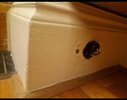Hi,
We purchased an old Victorian house which has the original inserts converted to gas. The fire was capped off. Someone came down to look and said it was fine to upcap it and replace the gas fire basket.
He fitted it and then informed me there was a small gas leak from the pipe where you turn the gas on (sorry not sure of the technical term).
But said it was in limits but should be fixed at some point but it was OK to use the fire.
I am having someone doing building works who used some gadget and it beeps when put aganist that pipe with the gas off.
I can't smell any gas.
But I am concerned, so is there an acceptable amount of gas?
I'm thinking of just having it shut off completely.
Here is a pic of where the leak is coming from.

We purchased an old Victorian house which has the original inserts converted to gas. The fire was capped off. Someone came down to look and said it was fine to upcap it and replace the gas fire basket.
He fitted it and then informed me there was a small gas leak from the pipe where you turn the gas on (sorry not sure of the technical term).
But said it was in limits but should be fixed at some point but it was OK to use the fire.
I am having someone doing building works who used some gadget and it beeps when put aganist that pipe with the gas off.
I can't smell any gas.
But I am concerned, so is there an acceptable amount of gas?
I'm thinking of just having it shut off completely.
Here is a pic of where the leak is coming from.


